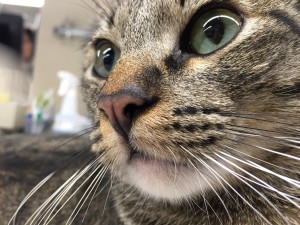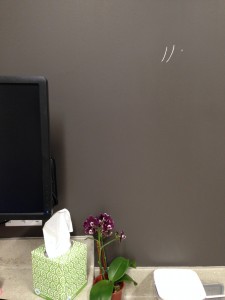Many of our domesticated felines have evolved from living primarily outdoors to a cushier indoor lifestyle. And with this switch has come some definite benefits. Indoor cats tend to live longer. Their owners are much more aware of their health and habits and are therefore able to bring them to the veterinarian for preventative care or quickly as soon as problems surface. Indoor felines also have an extremely low chance of contracting certain dangerous infections and deadly diseases like the Leukemia Virus and FIV (the feline form of HIV) - see previous blogs on each of these. Vehicular trauma is a thing of the past for these guys. But what might these creatures say if we could ask them about their new living conditions?
Some cats have retained many of the behaviors of their wild ancestors. While cats can certainly enjoy social interactions with other animals, not understanding the needs of a solitary hunter can create stress. Without a sense of control over their physical and social environment, stress can rule the cat’s life. Cats are fight-or-flight animals and may find new environments difficult (Think about the kitty who hides under the towel in the corner during the vet visit …or the one who leaves scratch marks on the exam room wall trying to “protect himself” from certain torture from the white-coated enemy!)
But these tendencies have evolved as protective mechanisms, essentially for their survival. Providing choices - multiple hiding, feeding, water and toilet options - will reduce the cat’s fear and give him a sense of control.
Wild cats are solitary hunters and the smaller felines will often attempt to eat 10-20 meals a day. While not all attempts to catch prey are successful, this sort of activity requires a lot of energy. Compare that to what Fluffy’s indoor lifestyle is like. Fluffy’s mom controls when and where she eats and not much energy is needed for Fluffy to consume her meal. Loosing these opportunities to display predatory behavior can be a stressor for some felines, leading to lack of physical and mental activity and resulting in obesity and other health problems. In multi-cat households, often food bowls are placed next to each other, which can increase competition for food resources and ultimately create stress in the cat’s life.
Cats are also crepuscular animals, meaning they prefer to be most active and hunt at dawn and dusk. (Has Fluffy ever woken you up at 5am by walking across your face?) Sometimes owners will inadvertently reinforce this behavior by giving the cat attention which makes for a long-term and frustrating problem.
Mama cats teach their offspring to hunt through play behavior. With a litter of kittens, they will practice this behavior by tumbling and tussling about with each other. Without playmates or a mama cat, you may find your feet and fingers a ready substitute. (Ever been bitten by a kitten’s dagger-like tooth?) As kittens, many owners find this behavior cute, but if not discouraged or re-directed, it can lead to a life of aggressive tendencies.
Toys, food puzzles and hiding the kibble around the house so that the cat has to “hunt” for his food can really help to allow the cat to display his natural behaviors in an acceptable and rewarding way. Cats in the wild drink water in locations very separate from food. Some cats prefer running water (ie. fountains, the dripping bathtub faucet) while others prefer still water. Ideally there are multiple water dishes located away from the food dish.
The goal of preparing a house for a cat is to provide the cat with a sense of control in locating its various resources safely and without restriction from another animal in the home. This means multiple litterboxes and food and water bowls located in different parts around the home. Litterboxes should always be kept very clean - cats are generally very fastidious. Ideally there are 2 entrances/exits in the box and it should be large enough for the cat to be able to turn around and scratch, approximately 1.5 times the length of the cat, from nose to tip of tail. There should be multiple safety “hiding” spots in various locations. Carriers are a perfect “hiding” spot to try to encourage since the cat would want to feel as safe as possible when coming to the vet in their carriers. Various “perching” areas can also provide a cat respite from a stressful situation and also allow them to monitor the scenario from afar. Be sure to provide scratching substrates in the main living area and by the cat’s favorite sleeping spot - cats naturally scratch when they wake up as part of stretching. They can also display this behavior at the periphery of the home where strange smells and scents may enter (by doors and windows).
Of course some cats are very agreeable with the indoor lifestyle and do not display behaviors that harken back to their wild roots. For those lucky owners, attention must still be paid to ensure that the cat is active enough. Obesity is much more common in the strictly indoor cat and can lead to serious health conditions like diabetes, heart disease and hypertension, not to mention arthritis and skin problems.
Cats are fascinating creatures. They enrich our lives in endless ways and yet are fairly independent. Understanding their natural tendencies not only increases our patience with them but can help us give them opportunities to express themselves so that they avoid stress, and in turn de-stress us too!

